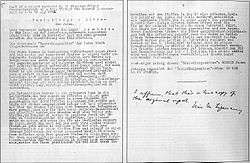Maximilian von Herff
Maximilian Karl Otto von Herff (17 April 1893 – 6 September 1945) was a high-ranking commander in the SS of Nazi Germany during World War II. The protestant von Herff family originated from Liège in Belgium and moved to the Palatinate in 1577 to escape religious persecution. His ancestor Christian Herff had been inducted into the noble class in 1814[1].
Maximilian von Herff | |
|---|---|
 Herff (front right) during the Warsaw Ghetto Uprising | |
| Born | 17 April 1893 Hanover, Kingdom of Prussia, German Empire |
| Died | 6 September 1945 (aged 52) Ulverston, England |
| Buried | Cannock Chase German war cemetery |
| Allegiance | |
| Service/ | Army, Waffen-SS |
| Rank | Obergruppenführer |
| Unit | |
| Commands held | Chef des Personalamtes der Waffen-SS |
| Battles/wars | World War I German Revolution of 1918–19
|
| Awards | Knight's Cross of the Iron Cross |
Early life
Maximilian von Herff was born in Hanover on 17 April 1893, the son of a General Practitioner.
After school, Maximilian von Herff joined the army and became Leutnant (second lieutenant) in the Leibgard-Infanterie-Regiment Nr. 115 (Prussian Army) in which unit he took part all through World War I. He stayed in the Reichswehr after the war, and in 1926 served as Oberleutnant (lieutenant) in the 18. Reiter-Regiment in Stuttgart. In Wehrmacht on 3 January 1939 von Herff reached the rank of Oberstleutnant (lieutenant-colonel).
World War II
During World War II, Herff served with the Deutsches Afrika Korps in North Africa. He was promoted to Oberst (colonel) and commanded "Kampfgruppe von Herff". For his service in North Africa he was awarded the Knight's Cross of the Iron Cross in June 1941[2].
At the suggestion of Heinrich Himmler he transferred to the Waffen-SS. On 1 April 1942 Herff joined the Nazi Party (member no. 8 858 661) and the SS (member no. 405 894). From 1 October 1942 to 8 May 1945, he was chief of the Persönlicher Stab Reichsführer-SS (Himmler's personal staff). He dealt with internal and financial SS matters.

In his later diary entries, Herff would claim to have had knowledge of the Final Solution but not have played any role in administrative or actual involvement in exterminations or deportations. However, on 14–15 May 1943, Von Herff was in Warsaw during the Warsaw Ghetto Uprising and supervised its suppression under orders from Himmler. His adjutant, Karl Kaleske wrote of the deportations carried out following the uprising to Auschwitz concentration camp and other camps where "special action" was required. Jürgen Stroop's report on the Warsaw Ghetto Uprising contains a photograph of Herff and Stroop taken during the May 1943 visit and confirms Von Herff's visit to the Ghetto 14 May 1943.[3]
On 20 April 1944, Herff was promoted to SS-Obergruppenführer (SS general)[4][5].
Capture and death
He was captured by British forces in 1945, and held at Grizedale Hall POW camp. He suffered a stroke and died at nearby Conishead Priory Military Hospital. He was later reburied at Cannock Chase German Military Cemetery, Staffordshire.
His sister Carin von Herff moved to London during his imprisonment where she would live for four years before returning to Germany with her French Huguenot husband, a former SS-Oberführer of the 33rd Waffen Grenadier Division of the SS Charlemagne (1st French).[6] Both were acquitted of any war crimes and along with Maximilian von Herff claim they were only involved in the Nazi Party base and Waffen-SS not the extermination of the Jews. The couple would later return to live in England in the 1960s.
His cousin was SS-Brigadeführer Eberhard Herf, senior police official and later executed war criminal.
Awards
- Knight's Cross of the Iron Cross on 13 June 1941 as Oberst and as commander of Kampfgruppe "von Herff" (Schützen-Regiment 115).[7]
References
Citations
- Genealogisches Handbuch des Adels, Bd. 52, 210/212. C.A.Starke Verlag.
- Fellgiebel, Walther-Peer (1986). Die Träger des Ritterkreuzes des Eisernen Kreuzes, 1939–1945. Die Inhaber der höchsten Auszeichnung des Zweiten Weltkrieges aller Wehrmachtteile. Pozun Verlag. ISBN 3-7909-0284-5.
- Stroop Daily report 14 May 1943; accessed 18 August 2018
- Dienstalterliste der Waffen-SS, SS-Obergruppenführer bis SS-Hauptsturmführer, Stand vom 1. Juli 1944, berichtigt 31.08.1944, 29.12.1944, 31.01.1945.
- von Preradovich, Nikolaus (1985). Die Generale der Waffen-SS. Kurt Vowinckel Verlag KG. ISBN 3-921-655-41-2.
- "The USA and us"-"The sins of the forefathers" J. Andreani,
- Scherzer 2007, p. 384.
Bibliography
- Scherzer, Veit (2007). Die Ritterkreuzträger 1939–1945 Die Inhaber des Ritterkreuzes des Eisernen Kreuzes 1939 von Heer, Luftwaffe, Kriegsmarine, Waffen-SS, Volkssturm sowie mit Deutschland verbündeter Streitkräfte nach den Unterlagen des Bundesarchives [The Knight's Cross Bearers 1939–1945 The Holders of the Knight's Cross of the Iron Cross 1939 by Army, Air Force, Navy, Waffen-SS, Volkssturm and Allied Forces with Germany According to the Documents of the Federal Archives] (in German). Jena, Germany: Scherzers Militaer-Verlag. ISBN 978-3-938845-17-2.